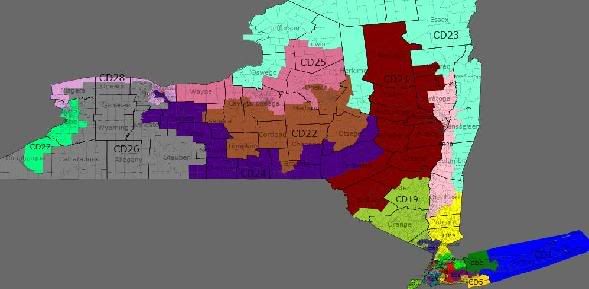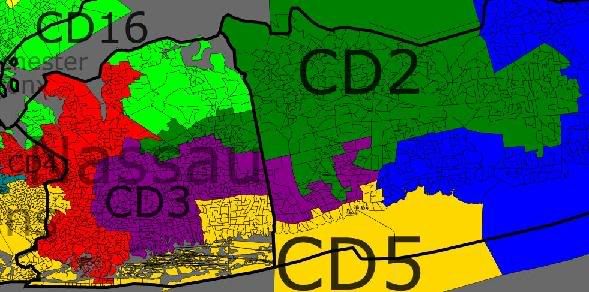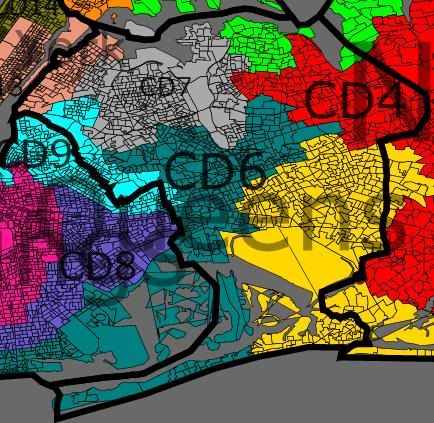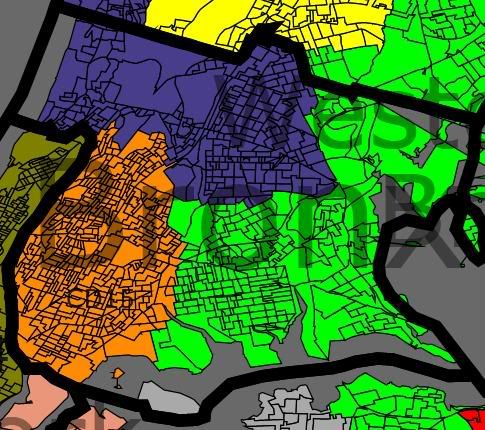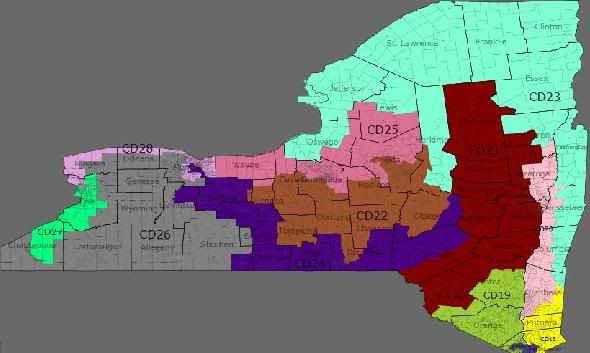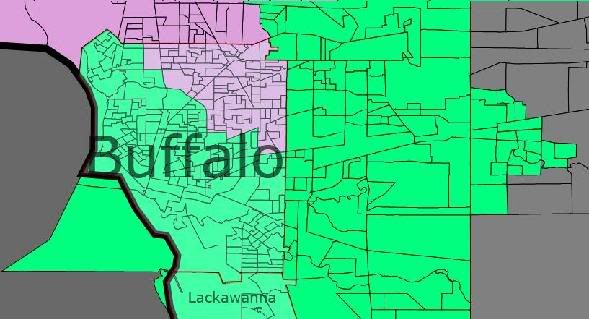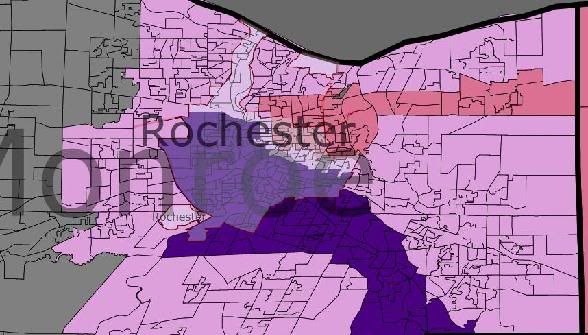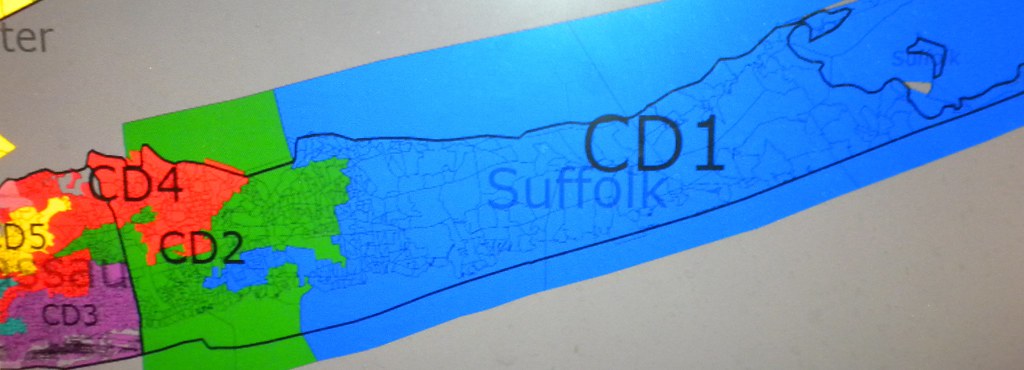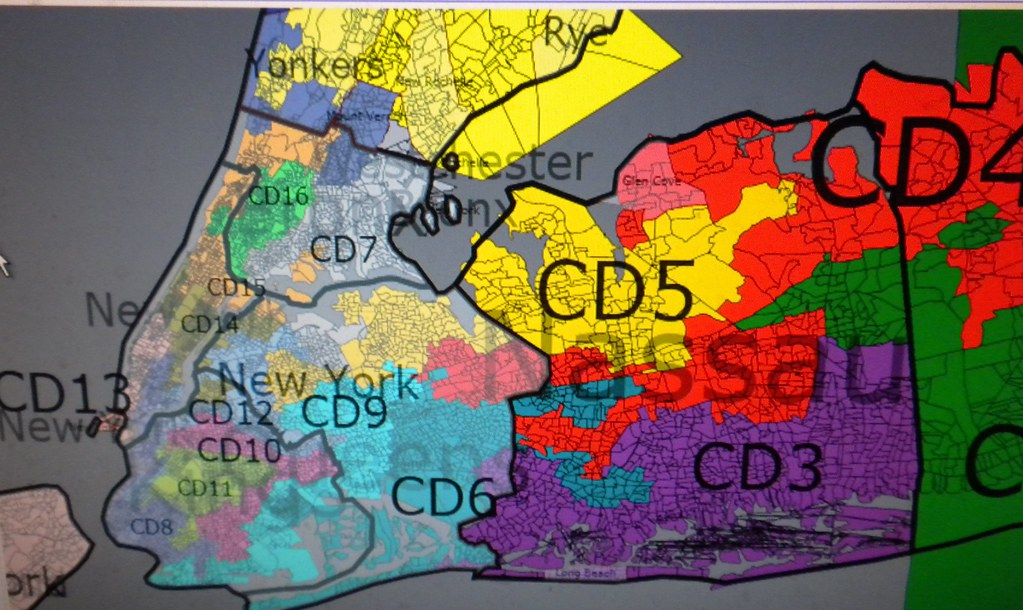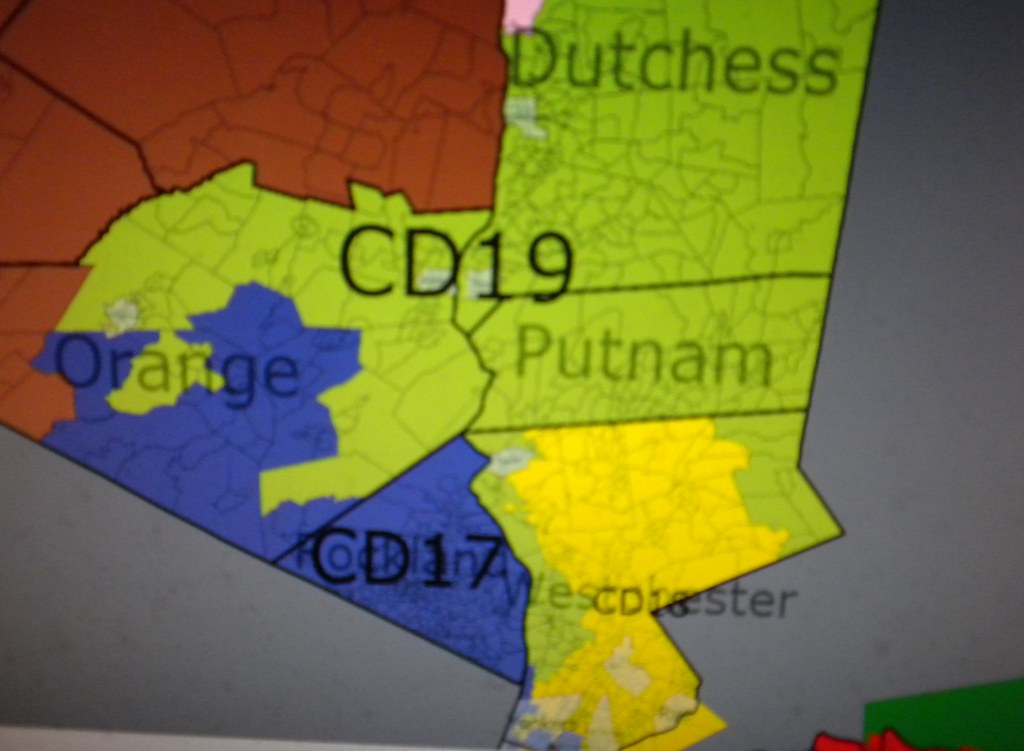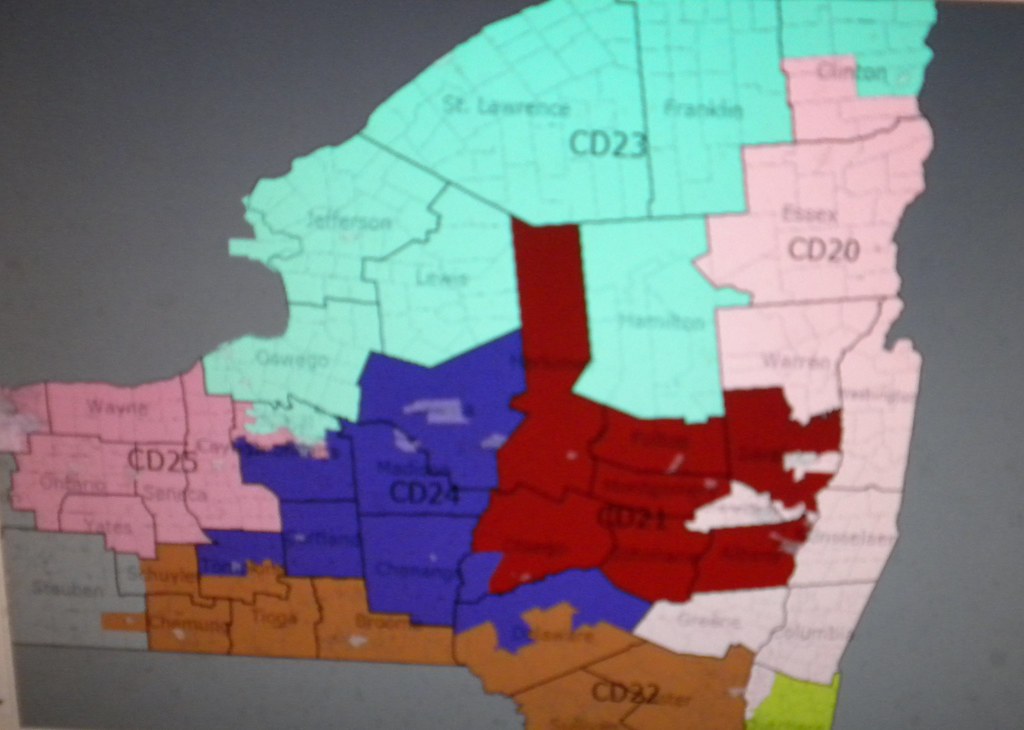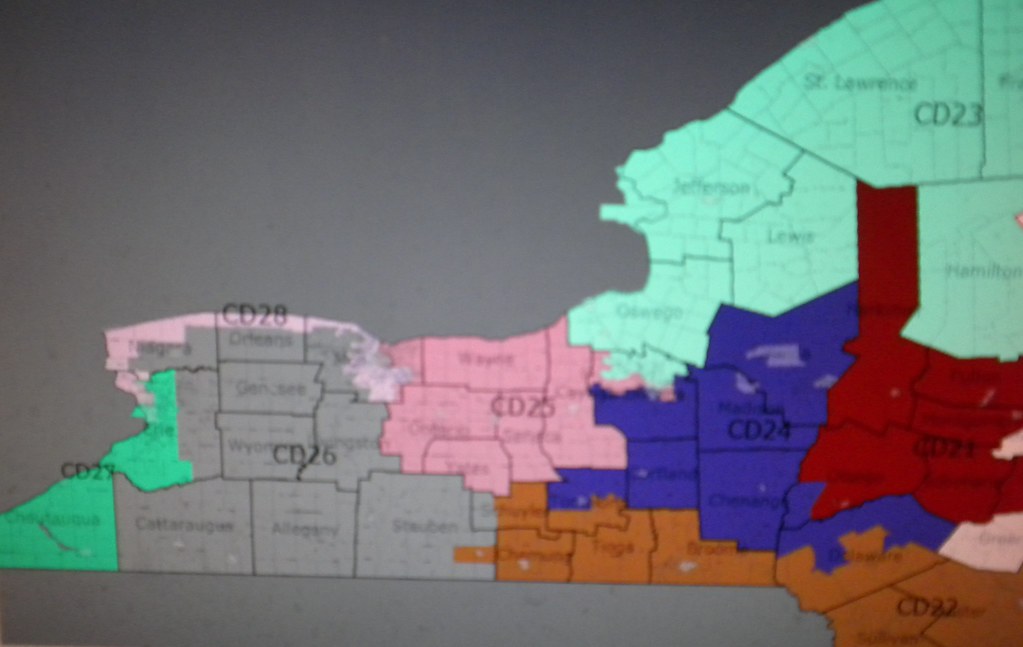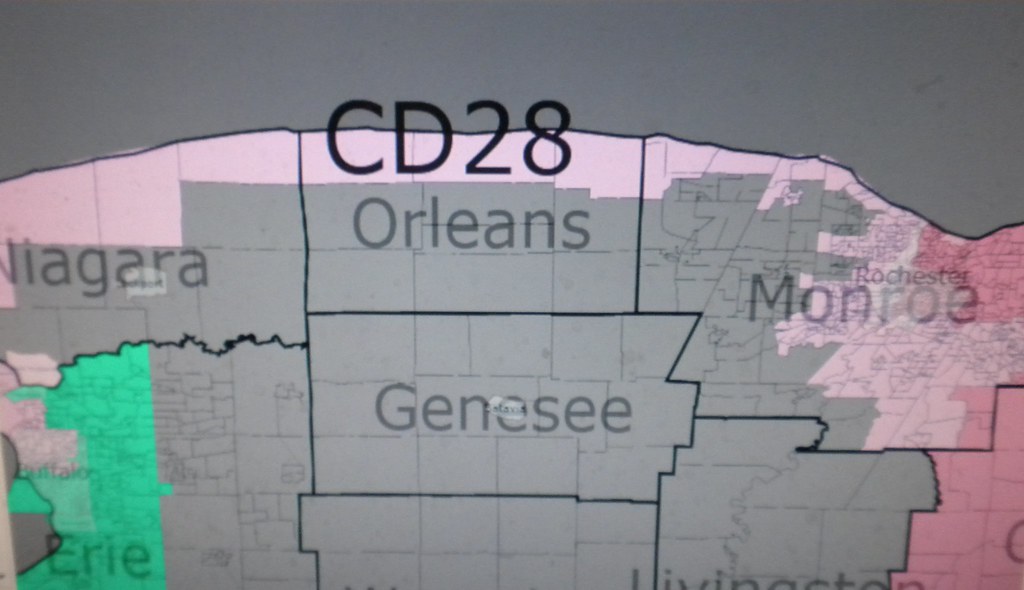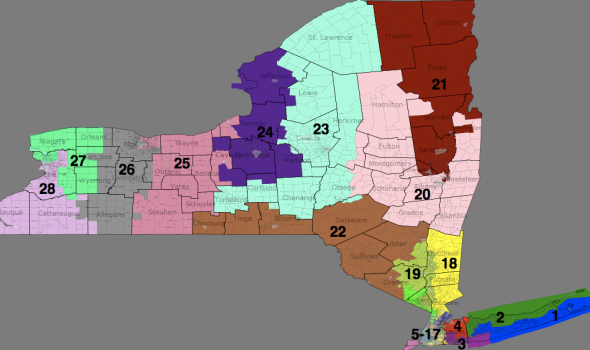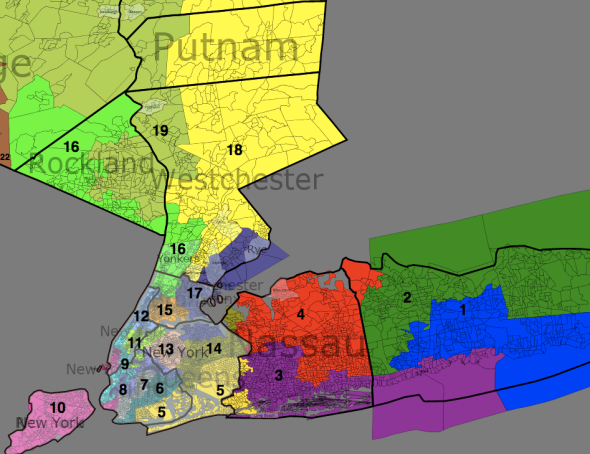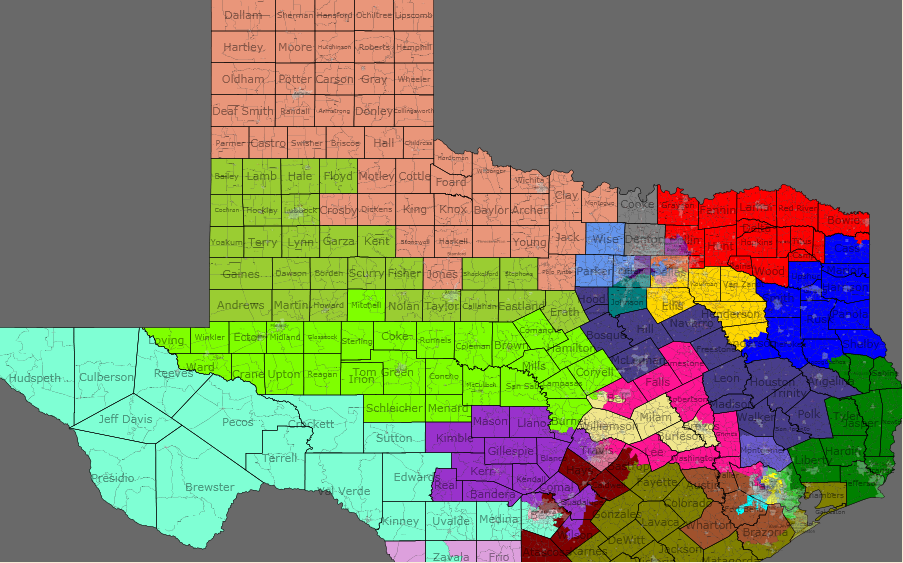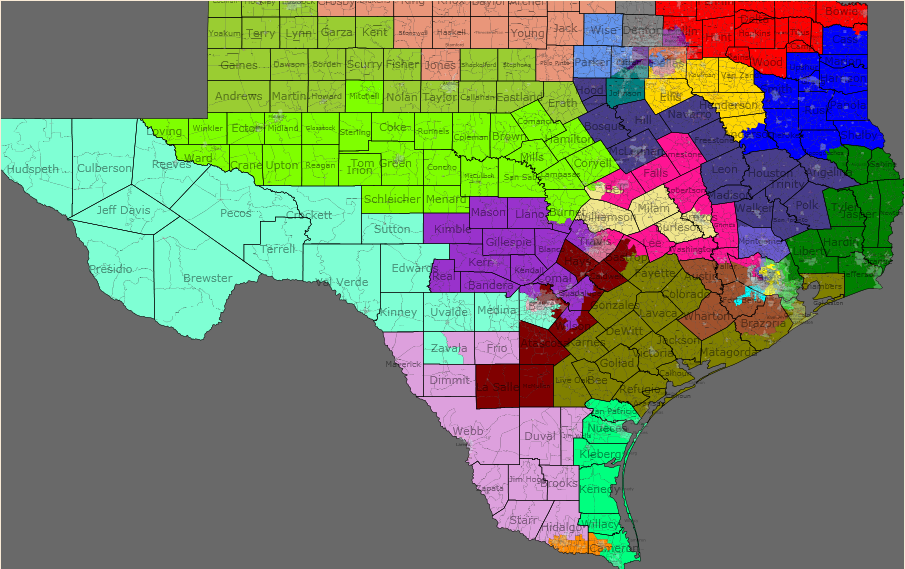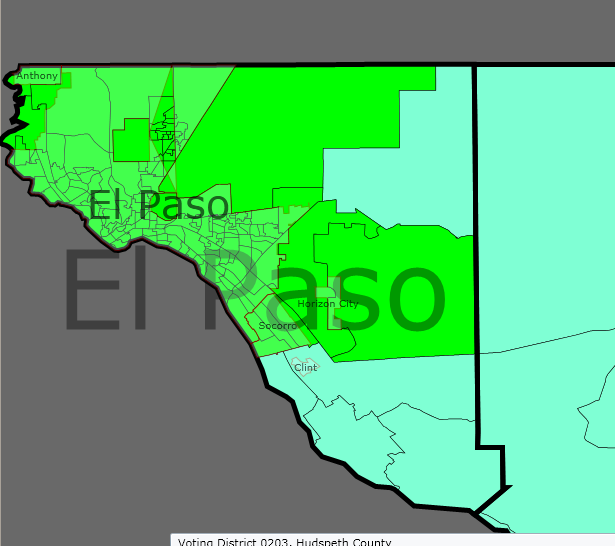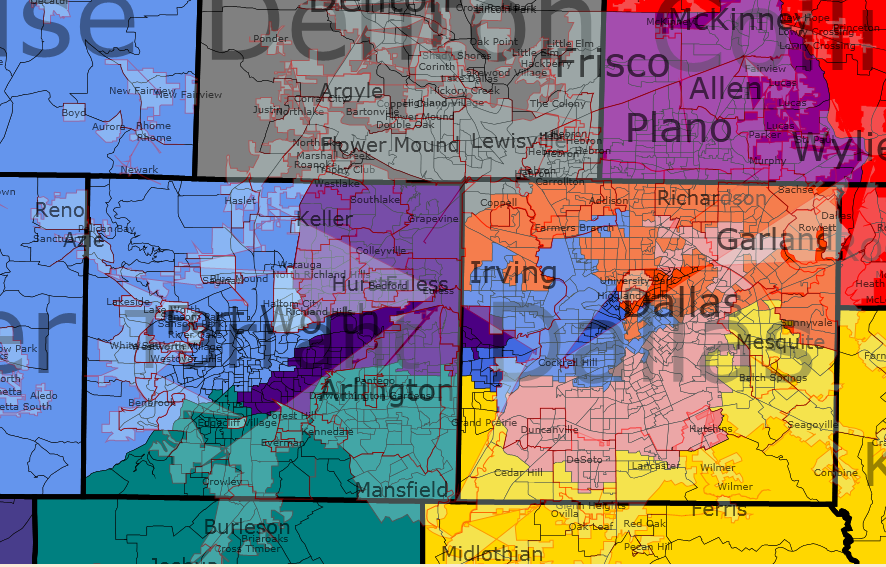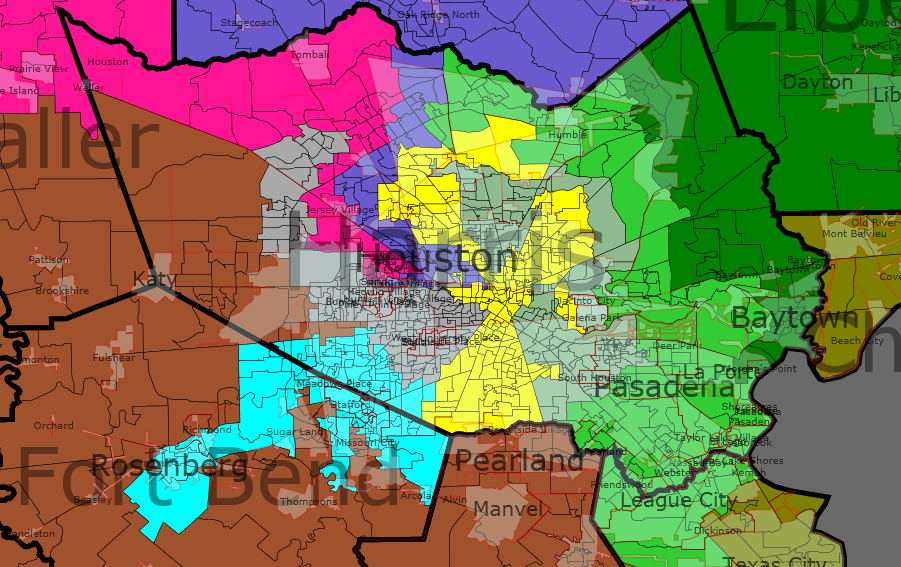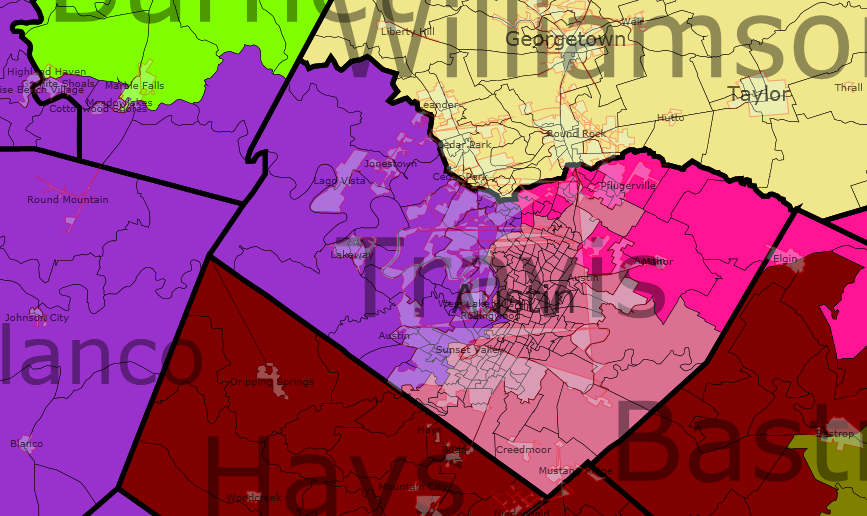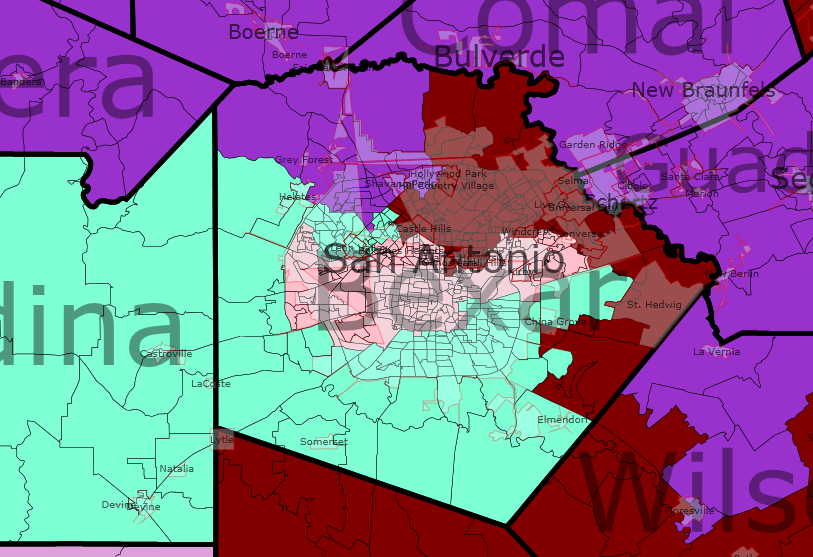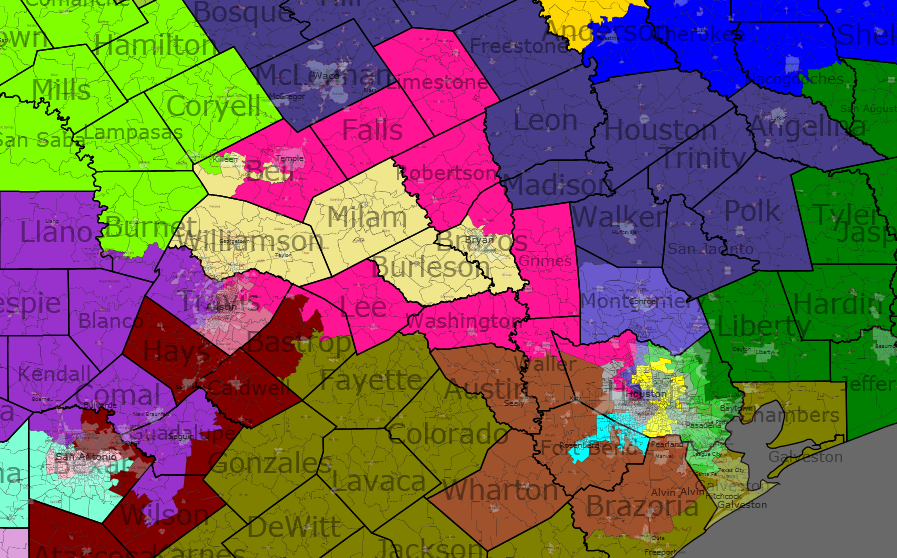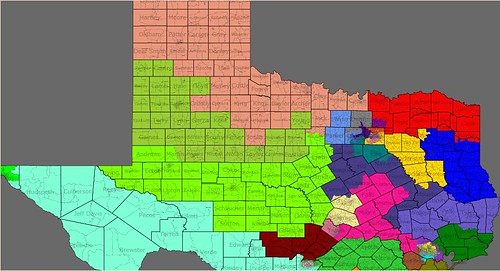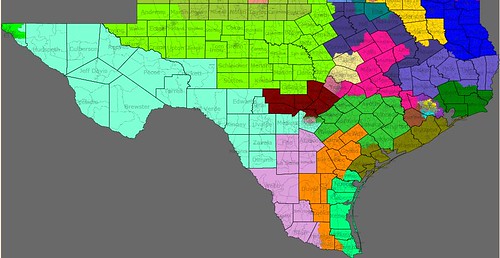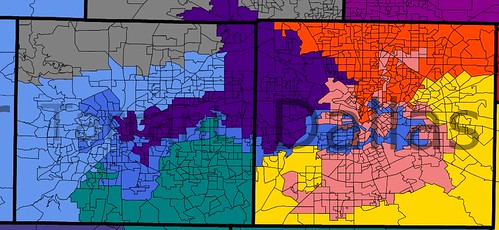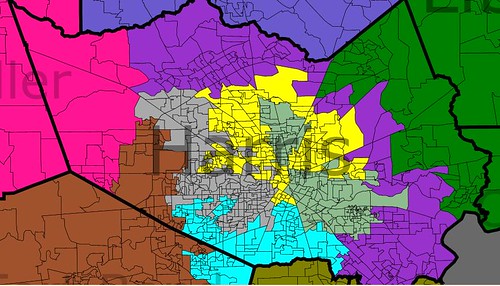Overall Plan
This entry in the redistricting contest creates 28 Democratic seats and 0 Republican seats. I expect Peter King to lose against Carolyn McCarthy, Chris Lee to lose against Brian Higgins, two Democrats to win in new districts, and one of Scott Murphy or Bill Owens to lose in a primary.
I aimed for compact districts, by and large. Some districts stretch this a little (e.g., 16 and 18), but most are more compact than they used to be. There are no earmuffs like NY-26. There are no water connections over uninhabited islands like NY-08. There’s no connecting through a Con Ed plant to pick up population from Rikers Island like NY-15. Perhaps the only cheap trick was connecting the new Velázquez district through Prospect Park. I even refrained from drawing a thin tendril from Meeks’s district to King’s house.
I was very careful to ensure that a representative actually lives in a district if I assert that I’m drawing a district for him or her. This was rather constraining in several cases. However, I avoided relying on incumbency to keep districts safe, since most of the NY delegation will retire before the next round of maps goes into effect in January 2023.
Along a similar line, I tried to keep Democratic incumbents with at least some of their base of support. For example, since Massa’s current district runs to the Rochester suburbs, I kept it that way rather than giving him some kind of Buffalo-based or Binghamton-based creation. (But when an incumbent, such as Slaughter, has two very distinct bases of support, I only aimed to keep one of them – in Slaughter’s case, it was Rochester rather than Buffalo.) Our incumbents have worked hard to build relationships with local leaders and activists in their current districts, and I’d rather not take that away from them.
All districts are within 100 votes of the target population, except for the three westernmost districts, which are within 200.
Districts by Geography
On Long Island, I’ve reconfigured the two Suffolk districts into an east-west alignment to even out the Democratic advantage between them. In Nassau, I’ve carved King’s district up between Ackerman (whose district is now almost entirely outside the City) and McCarthy, and placed some Republican areas along the NYC border into Meeks’s and Weiner’s districts.

In Queens, Meeks’s district is roughly the same as before, although it now encompasses some Black and Republican areas in Nassau and Brooklyn. Weiner’s district is still based in Forest Hills, but now spills eastward towards Nassau rather than westward into Brooklyn. Lowey’s new district reaches down into Whitestone. Crowley’s district has been consolidated into a compact area of western Queens, and Maloney still has about the same area.
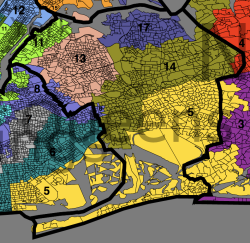
Most of Brooklyn is in VRA districts. Velázquez’s district is heavily Democratic, since I found that I had to use almost entirely Democratic precincts in order to build a 48% Hispanic district. However, I found that it was easy to build solidly Democratic 50% Black districts that had spare capacity to take on Republicans from southern Brooklyn. Therefore, most of southern Brooklyn is divided among the 50% Black VRA districts of Meeks, Towns, and Clarke. Most of the remainder (White Democratic areas like Brooklyn Heights and Park Slope) goes to Nadler, while McMahon and Maloney each represent small areas near the cores of their districts.
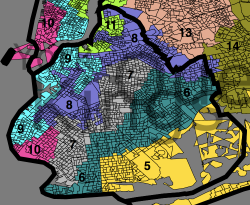
Staten Island is in McMahon’s district. If McMahon were to lose in 2010, I would want to split the island across two safely Democratic districts.
Lower Manhattan is split between McMahon (who needs the Democratic votes) and Nadler. Midtown and Uptown up to about 96th are split between Nadler and Maloney, as is roughly the case today. Harlem is still in Rangel’s district.

In the Bronx, Serrano’s district is substantially similar to its current form, although Rangel and Engel both get some of his current Democratic Hispanic votes. The rest is split among two of the districts districts that extend up into Westchester and beyond.
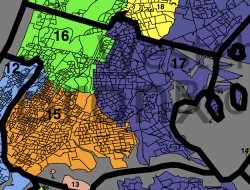
I have divided the northern Metro Area into four districts. Two (Engel and Lowey) have significant Democratic populations from New York City, which allows Engel to take Republican precincts from further Upstate. Hall also extends through Democratic areas nearly to NYC, which allows him to take Republican precincts from further Upstate as well. In particular, Rockland County is carefully divided between Republican precincts (which go to Engel) and Democratic precincts that can be used elsewhere. This allows me to create a fourth new district in the Hudson Valley, which goes from Poughkeepsie down to New City.
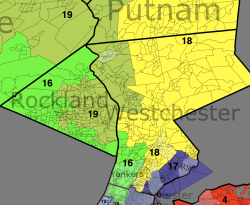
I split the Capital Region into two districts, one for Tonko and one for either Murphy or Owens. I judged Owens’s current district too tenuous to maintain in its existing form, so I split the North Country into three parts to attach to Maffei’s, Arcuri’s, and Murphy or Owens’s districts.

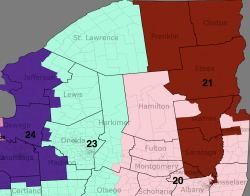
In Central New York, Utica and Syracuse each have one district. Binghamton also has a district, which extends eastward to Kingston and Middletown, as it does today. However, I transferred Ithaca from Hinchey to Arcuri in order to solidify Arcuri.
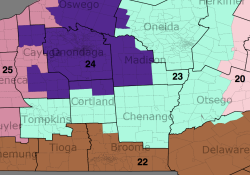
After the 2000 Census, the redistricters drew four districts for Western New York, intending to have them split 3-1 Republican. Their map connected parts of Rochester and Buffalo along a narrow strip to create a packed Democratic district, and then splintered the remaining Democrats among three other districts that they intended for Republicans. However, the four-district region as a whole leans Democratic, so one can create four Democratic districts just by giving each of the four districts an equal number of Democrats. In order to prevent Lee from stealing a district, I’ve put his residence into Higgins’s district and have drawn the incumbent-less district so that it has more Democrats than the other three.
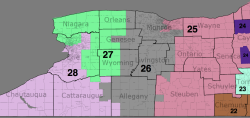
District Summaries
NY-01
Incumbent: Tim Bishop (D) lives in precinct Southampton 6.
Population: 700259
Population % by Race
| Wh |
Bl |
Hisp |
Asn |
Nat |
Oth |
| 75
|
6
|
15
|
2
|
0
|
2
|
Presidential Voting
|
New |
Old 1 |
| Obama % |
53.91
|
51
|
| McCain % |
45.56
|
48
|
Description: District 1 covers the southern half of Suffolk County, from Brentwood and Central Islip out to the Hamptons. It omits a strip of Republican land along the beach opposite Jones Beach and Fire Islands.
The current NY-01 was drawn to favor a former Republican incumbent, Felix Grucci, and contains all of Republican-leaning eastern Suffolk. In order to equalize the Democratic performance of Districts 1 and 2, I’ve reconfigured them so that each one gets a share of Republican-leaning eastern Suffolk. Thus, a large number of people from the North Fork are moving from NY-01 to NY-02, and a large number of people from the neighborhood of Brentwood and Central Islip are moving from NY-02 to NY-01.

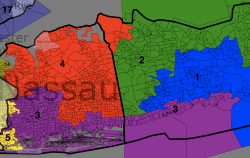
NY-02
Incumbent: Steve Israel (D) lives in precinct Huntington 100 in Dix Hills.
Population: 700383
Population % by Race
| Wh |
Bl |
Hisp |
Asn |
Nat |
Oth |
| 81
|
8
|
7
|
3
|
0
|
1
|
Presidential Voting
|
New |
Old 2 |
| Obama % |
53.36
|
56
|
| McCain % |
46.49
|
43
|
Description: District 2 covers the northern half of Suffolk County, from Huntington and Commack, out through Coram to the North Fork.


NY-03
Incumbents: Carolyn McCarthy (D) lives in precinct North Hempstead 111 in Mineola; Peter King (R) lives in precinct Hempstead 36 in Seaford.
Population: 700386
Population % by Race
| Wh |
Bl |
Hisp |
Asn |
Nat |
Oth |
| 73
|
11
|
11
|
3
|
0
|
2
|
Presidential Voting
|
New |
Old 3 |
Old 4 |
| Obama % |
53.23
|
47
|
58
|
| McCain % |
46.04
|
52
|
41
|
Description: District 3 covers Democratic southwestern Nassau County (Hempstead, Garden City, Valley Stream, Freeport) along with a strip of Republican territory on the shore well into Suffolk County.
In 2008, King outperformed McCain significantly in his district, while McCarthy outperformed Obama modestly in her district. In an incumbent-incumbent race, I expect McCarthy to be able to win in a D-leaning district with 22% Black+Hispanic, particularly since about 2/3 of the district’s population comes from her old NY-04.

NY-04
Incumbent: Gary Ackerman (D) lives in precinct North Hempstead 99 in Roslyn Heights.
Population: 700388
Population % by Race
| Wh |
Bl |
Hisp |
Asn |
Nat |
Oth |
| 79
|
6
|
8
|
6
|
0
|
1
|
Presidential Voting
|
New |
Old 3 |
Old 5 |
| Obama % |
52.88
|
47
|
63
| McCain % |
46.35
|
52
|
36
Description: District 4 covers most of northern and eastern Nassau County, including Levittown, Hicksville, Oyster Bay, and Port Washington.
This coincides in large part with Peter King’s old NY-03. However, it also includes Democratic territory around Plainview and Port Washington, and it excludes the Republican shore. If King moved into this new district, he could conceivably pull an upset if Ackerman has forgotten how to run a competitive race. (This would be similar to how Tim Holden upset George Gekas in central Pennsylvania after they were thrown together in a Republican-leaning district.)


NY-05
Incumbent: Gregory Meeks (D) lives in precinct Queens 33-28 in St. Albans.
Population: 700255
Population % by Race
| Wh |
Bl |
Hisp |
Asn |
Nat |
Oth |
| 28
|
50
|
11
|
5
|
0
|
5
|
Presidential Voting
|
New |
Old |
| Obama % |
78.94
|
89
|
| McCain % |
20.73
|
11
|
Description: As a VRA district, District 5 covers the Black areas of eastern Queens, St. Albans and Far Rockaway. It also covers several nearby Republican areas: the Five Towns, Rockaway Peninsula, and (through a connection across the Flatbush Ave. Bridge) Sheepshead Bay and Manhattan Beach.
This district achieves its required 50% Black population in southeastern Queens, and then uses its spare capacity to help achieve two goals: 1) It takes Republican votes from the Five Towns that might otherwise help King. 2) It helps break up the large White Republican sections of southern Brooklyn into irrelevant pieces. Currently, Weiner’s district achieves this second goal, but I prefer to use Weiner to inoculate Republican votes in Queens.
One more thing: For historical reasons, Section 5 of the VRA does not apply to Queens, only to the other three major boroughs. I think it would be a good thing to investigate whether Meeks’s district could be broken up to help out McCarthy and Ackerman against King. Meeks could still win a ~40% Black district handily. But maybe there’s a Section 2 thing that I’m not understanding?



NY-06
Incumbent: Ed Towns (D) lives in precinct 54-56 in East New York.
Population: 700355
Population % by Race
| Wh |
Bl |
Hisp |
Asn |
Nat |
Oth |
| 30
|
50
|
13
|
4
|
0
|
3
|
Presidential Voting
|
New |
Old 10 |
| Obama % |
79.82
|
91
|
| McCain % |
19.9
|
9
|
Description: As a VRA district, District 6 covers certain Black areas of Brooklyn (East New York, Brownsville, Canarsie, Flatlands). It also covers some nearby Republican areas around Gravesend and Brighton Beach.
This is another “Blacks and Republicans” district that achieves its required 50% Black population in one area, and then stretches out to White southern Brooklyn to split up the McCain votes there.

NY-07
Incumbent: Yvette Clarke (D) lives in precinct Brooklyn 43-78 in Prospect Gardens.
Population: 700389
Population % by Race
| Wh |
Bl |
Hisp |
Asn |
Nat |
Oth |
| 31
|
50
|
9
|
7
|
0
|
3
|
Presidential Voting
|
New |
Old 11 |
| Obama % |
79.31
|
90
|
| McCain % |
20.33
|
9
|
Description: As a VRA district, District 7 covers certain Black areas of Brooklyn (Bed-Stuy and Crown Heights). It also covers some nearby Republican areas, such as Mapleton and Bensonhurst.
This is another “Blacks and Republicans” district that achieves its required 50% Black population in one area, and then stretches out to White southern Brooklyn to split up the Republican votes there. Currently, Nadler’s district does this, but I prefer to make Nadler’s district less spectacularly gerrymandered than it is today.

NY-08
Incumbent: Nydia Veláquez (D) lives in precinct Brooklyn 72-100 in Carroll Gardens.
Population: 700328
Population % by Race
| Wh |
Bl |
Hisp |
Asn |
Nat |
Oth |
| 19
|
20
|
48
|
9
|
0
|
4
|
Presidential Voting
|
New |
Old 12 |
| Obama % |
88.22
|
86
|
| McCain % |
11.14
|
13
|
Description: As a VRA district, District 8 covers Hispanic areas of Brooklyn (Bushwick, some of Williamsburg, Boerum Hill, Sunset Park, and Kensington). It connects the two large Hispanic populations with a narrow strip through Prospect Heights and Prospect Park.
The Hispanic population of Brooklyn is barely large and concentrated enough to sustain a high-percentage district. Because of this, I avoided putting any nearby non-Hispanic areas in the district, such as Park Slope, Greenpoint, or the Republican sections of southern Brooklyn.


NY-09
Incumbent: Jerrold Nadler (D) lives in precinct Manhattan 35-67 on the Upper West Side.
Population: 700352
Population % by Race
| Wh |
Bl |
Hisp |
Asn |
Nat |
Oth |
| 52
|
11
|
18
|
16
|
0
|
3
|
Presidential Voting
|
New |
Old 8 |
| Obama % |
85.33
|
74
|
| McCain % |
13.85
|
25
|
Description: District 9 runs from the UWS, through Chelsea, and over to the LES. Then it crosses the Brooklyn and Manhattan Bridges, and covers several neighborhoods in Brooklyn: Brooklyn Heights, Park Slope, Red Hook, and Bay Ridge.
The Brooklyn portion of the district consists (by and large) of White Democratic neighborhoods. These are the neighborhoods that are not covered by the VRA districts.
I would ideally like to extend this district far enough down into Bay Ridge so that McMahon’s district would contain none of Brooklyn. However, it is difficult to do this and still have the district reach Nadler’s apartment on 70th St. In the end, I’m satisfied that McMahon’s district is sufficiently Democratic.


NY-10
Incumbent: Mike McMahon (D) lives in precinct Staten Island 61-35 on the northern part of the island (I don’t know neighborhood names).
Population: 700426
Population % by Race
| Wh |
Bl |
Hisp |
Asn |
Nat |
Oth |
| 72
|
7
|
11
|
8
|
0
|
2
|
Presidential Voting
|
New |
Old 13 |
| Obama % |
57.29
|
49
|
| McCain % |
41.95
|
51
|
Description: District 10 covers all of Staten Island, part of Bay Ridge in Brooklyn (connected by the Verrazano-Narrows Bridge), and the western half of Lower Manhattan (connected by the Staten Island Ferry).
The existing NY-13 was drawn to favor former Republican congressman Vito Fossella. A major goal of any Democratic redistricting should be to make this into a safe Democratic district. I accomplish this by adding a large portion of heavily Democratic Lower Manhattan. If there were a Republican incumbent, I would have split Staten Island into two pieces in order to guarantee the Republican’s defeat. However, that seems like overkill to shore up the seat for a sitting Democrat.


NY-11
Incumbent: Carolyn Maloney (D) lives in an unknown precinct on the Upper East Side (I’m assuming between 59th and 96th).
Population: 700270
Population % by Race
| Wh |
Bl |
Hisp |
Asn |
Nat |
Oth |
| 70
|
4
|
13
|
4
|
0
|
3
|
Presidential Voting
|
New |
Old 14 |
| Obama % |
77.09
|
78
|
| McCain % |
22.06
|
21
|
Description: District 11 covers the Upper East Side and Midtown East in Manhattan, Astoria and Long Island City in Queens, and Greenpoint and Williamsburg (the non-Hispanic parts) in Brooklyn. Although not visible on the Brooklyn map, the two sections of Brooklyn are connected by a couple precincts near the waterfront.
This district is very similar to Maloney’s current district.



NY-12
Incumbent: Charlie Rangel (D) lives in precinct Manhattan 70-31 in Harlem.
Population: 700336
Population % by Race
| Wh |
Bl |
Hisp |
Asn |
Nat |
Oth |
| 13
|
31
|
51
|
3
|
0
|
2
|
Presidential Voting
|
New |
Old 15 |
| Obama % |
93.62
|
93
|
| McCain % |
5.79
|
6
|
Description: District 12 covers Harlem (including Spanish Harlem) and Washington Heights, as well as a bit of the South Bronx. It has majority-minority (in fact, majority Hispanic) population.
Although this district has traditionally been considered a Black district, it is now majority Hispanic. There is a strong possibility of a Hispanic representative once Rangel retires or is driven out of office because of corruption.
I live in this district.


NY-13
Incumbent: Joe Crowley (D) lives in precinct Queens 30-45 in Woodside.
Population: 700405
Population % by Race
| Wh |
Bl |
Hisp |
Asn |
Nat |
Oth |
| 33
|
6
|
38
|
19
|
0
|
3
|
Presidential Voting
|
New |
Old 7 |
| Obama % |
71.26
|
79
|
| McCain % |
27.99
|
20
|
Description: District 13 covers several neighborhoods in Queens, including Jackson Heights, Corona, and Middle Village.
This district is quite different from the old NY-07, which reaches into the Bronx. I’m not sure why NY-07 has such a strange shape, and I see no good reason for it.
District 13 is a rare diverse district in the age of VRA-based segregation – no racial group exceeds 40% of the population. If Crowley retires in the coming decade, one could imagine a White, Hispanic, or Asian representative from this district. The Black voting population is actually slightly lower than 6%, since the district includes 8000 Black inmates at Rikers Island.

NY-14
Incumbent: Anthony Weiner (D) lives in precinct Queens 28-36 in Forest Hills.
Population: 700334
Population % by Race
| Wh |
Bl |
Hisp |
Asn |
Nat |
Oth |
| 41
|
8
|
19
|
24
|
0
|
8
|
Presidential Voting
|
New |
Old 9 |
| Obama % |
66.67
|
55
|
| McCain % |
32.64
|
44
|
Description: District 14 covers several neighborhoods in Queens. Starting at Howard Beach, it comes up through Ozone Park to Forest Hills, and then goes eastbound along the LIE to Little Neck. It also contains Great Neck in Nassau County, in order to isolate the Republican voters there from Peter King.
This district is more Democratic than the existing NY-09. That’s because the existing map uses NY-09 to fracture the Republican vote in southern Brooklyn. Instead, I use Meeks’s more heavily Democratic district to fracture Republicans in Brooklyn.


NY-15
Incumbent: José E. Serrano (D) lives in precinct Bronx 77-74 in the South Bronx.
Population:700362
Population % by Race
| Wh |
Bl |
Hisp |
Asn |
Nat |
Oth |
| 2
|
32
|
62
|
2
|
0
|
2
|
Presidential Voting
|
New |
Old 16 |
| Obama % |
94.60
|
95
|
| McCain % |
5.20
|
5
|
Description: District 15 covers the South Bronx, including the area just west of the Whitestone Bridge (Soundview?). It has a 60% Hispanic supermajority.
This district is substantially similar to the existing NY-16. However, it allows Engel to take some more Democratic votes from around Fordham campus.

NY-16
Incumbent: Eliot Engel (D) lives in precinct Bronx 81-67 in Riverdale.
Population: 700249
Population % by Race
| Wh |
Bl |
Hisp |
Asn |
Nat |
Oth |
| 53
|
14
|
26
|
5
|
0
|
3
|
Presidential Voting
|
New |
Old 17 |
| Obama % |
63.08
|
62
|
| McCain % |
36.26
|
38
|
Description: District 16 covers the northwestern Bronx (Riverdale, Kingsbridge, Bedford Park) and Yonkers. It then crosses the Hudson and picks up Republican areas along the New Jersey border in Rockland and Orange Counties.
Because this district gets so many Democratic votes from the Bronx and Yonkers, it can very selectively include only Republican voting districts in Rockland County. Many voting districts in Rockland County are either very Republican or very Democratic (possibly because of the separation of the Orthodox Jewish communities from other towns up there). As a result, the remainder of Rockland County can provide a core of Democratic votes for a district in the Hudson Valley. Obama lost District 16’s portion of Rockland County (134k population) by 16%, but won the remainder (167k population) by 23%.



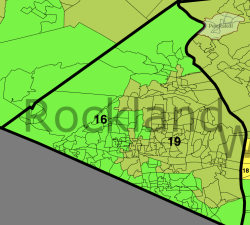

NY-17
Incumbent: Nita Lowey (D) lives in precinct Harrison 10 near Rye.
Population: 700372
Population % by Race
| Wh |
Bl |
Hisp |
Asn |
Nat |
Oth |
| 43
|
23
|
21
|
10
|
0
|
3
|
Presidential Voting
|
New |
Old 18 |
| Obama % |
71.91
|
62
|
| McCain % |
27.53
|
38
|
Description: Within New York City, District 17 covers Whitestone in Queens and most of the eastern Bronx. It then continues along the shore (New Rochelle and Rye).
Nita Lowey used to represent parts of Bronx and Queens, and she can again. In compensation for taking away most of her current district’s population, I’ve given her a heavily Democratic district majority-minority district.



NY-18
Incumbent: John Hall (D) lives in precinct Dover 1 in Dover Plains.
Population:700344
Population % by Race
| Wh |
Bl |
Hisp |
Asn |
Nat |
Oth |
| 74
|
11
|
10
|
3
|
0
|
2
|
Presidential Voting
|
New |
Old 19 |
| Obama % |
58.07
|
51
|
| McCain % |
41.05
|
48
|
Description: District 18 starts in Democratic Mt. Vernon next to the Bronx, and snakes its way up through Democratic White Plains to rural Putnam and Dutchess Counties.
This district is heavily Democratic, without cutting into the Hudson Valley precincts that I need for the new Democratic-leaning District 19.



NY-19
Incumbent: None.
Population: 700376
Population % by Race
| Wh |
Bl |
Hisp |
Asn |
Nat |
Oth |
| 71
|
11
|
12
|
3
|
0
|
3
|
Presidential Voting
|
New |
| Obama % |
58.20
|
| McCain % |
40.79
|
Description: District 19 lies in the Hudson Valley, including Poughkeepsie, Newburgh, Peekskill, and the Democratic portions of Rockland County. (See description of District 16 above.)
Although this district strongly favors Democrats at the federal level, there is no Democratic incumbent. Furthermore, the state legislators are all Republican, as are the mayors of Poughkeepsie and Newburgh. I believe that a Democratic non-politician along the lines of Hall, Murphy, or Owens would claim this seat. However, if the DCCC failed to recruit effectively, this district could fall to a local Republican.
Neither Sue Kelly (lost to Hall in 2006), John Sweeney (lost to Gillibrand in 2006), nor Jim Tedisco (lost to Murphy in 2009) lives in this district.



NY-20
Incumbent: Paul Tonko (D) lives in precinct Amsterdam city 1.
Population: 700342
Population % by Race
| Wh |
Bl |
Hisp |
Asn |
Nat |
Oth |
| 89
|
6
|
3
|
1
|
0
|
1
|
Presidential Voting
|
New |
Old 21 |
| Obama % |
54.49
|
58
|
| McCain % |
43.68
|
40
|
Description: District 20 contains part of the Capital Region, including Albany.
This district is slightly less Democratic than its predecessor. Most notably, it gives up Democratic Schenectady and Troy in order to make the new District 21 safer.




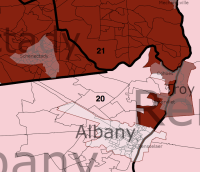
NY-21
Incumbent: Scott Murphy (D) lives in precinct Glens Falls 5; Bill Owens (D) lives in precinct Plattsburgh 3.
Population: 700425
Population % by Race
| Wh |
Bl |
Hisp |
Asn |
Nat |
Oth |
| 92
|
3
|
2
|
1
|
0
|
1
|
Presidential Voting
|
New |
Old 20 |
Old 23 |
| Obama % |
54.90
|
51
|
52
|
| McCain % |
43.41
|
48
|
47
|
Description: District 21 runs along the Vermont border, containing Schenectady, Troy, Saratoga Springs, and Plattsburgh.
The existing NY-20 and NY-23 were both created for Republican incumbents, and neither is particularly attractive to Democrats. Rather than contort district boundaries to preserve seats for both of these Blue Dogs, I prefer to carve up the moderate/Republican North Country to give safer seats to one of them and to Arcuri.
In a head-to-head primary, both candidates would have a reasonable chance of winning, since many of the Democratic votes would come from around Schenectady and Troy, which are presently in Tonko’s district.
Of course, there’s a real chance that one of these incumbents will lose in 2010. If that happens, then this district should favor the Democratic incumbent. Jim Tedisco (lost to Murphy) and Doug Hoffman (lost to Owens) both live in this district, but Dede Scozzafava (withdrew against Owens) does not.



NY-22
Incumbent: Maurice Hinchey (D) lives in precinct Hurley 3.
Population: 700380
Population % by Race
| Wh |
Bl |
Hisp |
Asn |
Nat |
Oth |
| 87
|
5
|
5
|
2
|
0
|
1
|
Presidential Voting
|
New |
Old |
| Obama % |
53.24
|
59
|
| McCain % |
45.30
|
39
|
Description: District 22 contains Kingston, Middletown, Binghamton, and Elmira.
Giving Democratic Ithaca to Hinchey only makes sense if one is trying to pack Upstate Democratic votes in order to create Republican seats. This new district has enough Democrats from Binghamton and the Hudson Valley to be easily winnable.
Hinchey (born 1938) will probably retire during the next decade, and Republicans could make a play for this district in an open-seat election. However, the eastern part of the district is quickly becoming more Democratic (see Sue Kelly and John Sweeney), and I would expect Democrats to hold the seat.
Since the average district size increased by 4%, this new District 22 can span about the same amount of longitude without looking quite as goofy as the old NY-22.



NY-23
Incumbent: Michael Arcuri (D) lives in precinct Utica 4.
Population: 700382
Population % by Race
| Wh |
Bl |
Hisp |
Asn |
Nat |
Oth |
| 92
|
3
|
2
|
2
|
0
|
1
|
Presidential Voting
|
New |
Old 24 |
| Obama % |
52.62
|
50
|
| McCain % |
45.66
|
48
|
Description: District 23 contains Potsdam, Utica, and Ithaca.
Arcuri looked surprisingly weak in the 2008 election. However, with the advantage of incumbency and a district that’s a few percent safer, he should be able to hold his seat. He is one of the few Democratic incumbents who may stay in Congress until 2030.


NY-24
Incumbent: Dan Maffei (D) lives in precinct DeWitt 3 near Syracuse.
Population: 700338
Population % by Race
| Wh |
Bl |
Hisp |
Asn |
Nat |
Oth |
| 87
|
7
|
2
|
2
|
1
|
2
|
Presidential Voting
|
New |
Old 25 |
| Obama % |
55.45
|
56
|
| McCain % |
42.76
|
43
|
Description: District 24 contains Syracuse and Watertown.
This is the safest of the seats in the central part of the state. Its Democratic performance is similar to Maffei’s old district, but it crucially takes its non-Syracuse Democratic votes from the North rather than from the Rochester area. This allows the Rochester area to be split into Democratic-leaning districts.


NY-25
Incumbent: Eric Massa (D) lives in Corning city.
Population: 700395
Population % by Race
| Wh |
Bl |
Hisp |
Asn |
Nat |
Oth |
| 91
|
4
|
2
|
1
|
0
|
1
|
Presidential Voting
|
New |
Old 29 |
| Obama % |
52.64
|
48
|
| McCain % |
45.92
|
50
|
Description: District 25 is based in the Rochester area, containing the eastern part of the city, and most of the northeastern suburbs. It goes along the Lake Ontario coast as far East as Oswego, and also extends to the Finger Lakes Region (Auburn, Geneva, Canandaigua) and down through rural areas to the Pennsylvania border.
This district is much safer for Massa than the old NY-29.


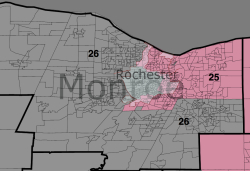
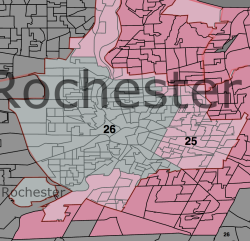
NY-26
Incumbent: Louise Slaughter (D) lives in precinct Perinton 14 in Fairport.
Population: 700170
Population % by Race
| Wh |
Bl |
Hisp |
Asn |
Nat |
Oth |
| 80
|
12
|
5
|
2
|
0
|
1
|
Presidential Voting
|
New |
Old 28 |
| Obama % |
53.00
|
68
|
| McCain % |
45.73
|
30
|
Description: District 26 is also based in the Rochester area, containing the western part of the city and most of the suburbs. It contains rural areas (including Livingston and Allegany Counties) going South to the Pennsylvania border.
To create more safe Democratic seats in western New York, I give Slaughter’s Buffalo Democrats to the new NY-27 and give some of her Rochester Democrats to Massa in the new NY-25.



NY-27
Incumbent: None.
Population: 700157
Population % by Race
| Wh |
Bl |
Hisp |
Asn |
Nat |
Oth |
| 84
|
11
|
2
|
2
|
1
|
1
|
Presidential Voting
|
New |
Old 26 |
| Obama % |
54.55
|
46
|
| McCain % |
43.90
|
52
|
Description: District 27 is based in the Buffalo area, containing the northern part of the city, Niagara Falls, and rural areas to the North and East.
On a map, it may appear as though this district should “belong” to Lee, if he decided to move into it. However, only about 300k of the residents are part of Lee’s current district. Nearly as many (270k) are part of Slaughter’s current district, and the remainder are largely Democrats from Higgins’s district.
Because there is no Democratic incumbent here, I’ve made it the safest Democratic seat of western New York. If Lee did decide to run here, he would face a very tough district full of Democrats who don’t know him. Furthermore, Lee is not a strong candidate. Despite a bitter three-way Democratic primary in 2008 that produced a weak candidate, Lee barely managed to outpoll McCain in his current district.
Byron Brown (mayor of Buffalo) and Alice Kryzan (lost to Lee in 2008) live in this district. Jon Powers (lost in the primary to Kryzan in 2008) and Tom Reynolds (retired in 2008) do not. I don’t know about Jack Davis (lost several times).

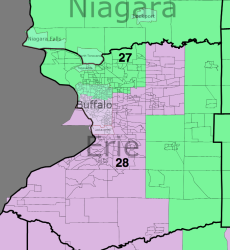
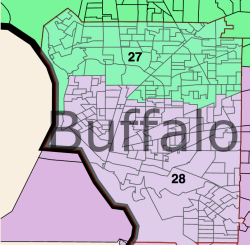
NY-28
Incumbents: Brian Higgins (D) lives in precinct South 19 in Buffalo; Chris Lee (R) lives in an unknown precinct in Clarence.
Population: 700176
Population % by Race
| Wh |
Bl |
Hisp |
Asn |
Nat |
Oth |
| 85
|
8
|
4
|
1
|
1
|
1
|
Presidential Voting
|
New |
Old 27 |
| Obama % |
54.23
|
54
|
| McCain % |
44.11
|
44
|
Description: District 28 is based in the Buffalo area, containing the southern part of the city, the eastern and southern suburbs, and rural Chautauqua and Cattaraugus Counties.
Higgins would certainly beat Lee in an incumbent-incumbent matchup. A considerable majority of the population comes from Higgins’s old district, and the district leans safely to Democrats.




Loading ...
